Proper piping in the bathroom and toilet: an overview of the main design errors
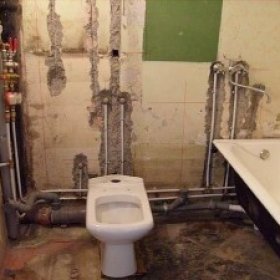
When it comes to repairs in the bathroom, there is no way to do without replacing plumbing communications. Moreover, it is not always a question of dismantling old pipes and laying new ones in their place. As a rule, if the owner undertakes a cardinal arrangement of the bathroom, it involves improving the ergonomics of the usable space, combining or vice versa the separation of the bathroom and toilet, installing modern plumbing and household appliances, and improving the design. Naturally, such events are associated with the laying of both new water mains and drainage. In a word, you need a new pipe layout in the bathroom.
Content
How to develop a wiring diagram?
A professionally developed plan for converting a bathroom is a key point in creating comfort and coziness in a home, in principle, in order to end up with a single system, which means that all its elements must be “linked” to each other in such a way that the operation of each of them separately is maximized functional and efficient.
As for the bathroom, the correct system in the bathroom, even with the smallest overall dimensions, will turn it into a corner of comfort and relaxation. To begin with, a clear layout of all plumbing products to which a particular pipeline will be supplied is developed. It should be noted here that if the toilet is a separate room, then the piping in the toilet should be carried out in conjunction with the bathroom.
Before you familiarize yourself with all the nuances of proper installation, we suggest you look at a good example of a job well done.
Video: how to properly pipe pipes in the bathroom and toilet
Choose the appropriate installation method
After a careful study of the sketch, where all the markings and dimensions are plotted and a well-thought out wiring diagram, you will have to think about how all this will be implemented in practice. In principle, there should be no particular difficulties with this, since pipes can be bred in one of two ways - open or hidden.
An open way is when the pipelines of communications are outside. It is characterized by simple installation work, but the aesthetic parameters leave much to be desired. Even if all communications pass as close to the floor surface as possible.
A hidden method implies that pipes are hidden in wall structures. Everything is in order with visual perception here - highways simply will not be visible. But to carry out installation in this way is an extremely difficult undertaking. For example, gating takes a lot of energy. It is important to note that wall gating with hidden wiring cannot be performed in load-bearing walls.
The hidden placement of water pipes requires particularly careful installation, because when a leak appears, it will not be easy to eliminate it. For this reason, the best option is a system built using copper or polypropylene pipes - they are completely not subject to corrosion, so they can last longer than metal ones. It is not recommended to build a hidden water supply system from metal-plastic pipes. During operation, it will be necessary to periodically check and tighten the threaded connections of the fittings, which will not be easy to do on the trunk hidden behind the exterior.
We continue to work with the wiring diagram, now we need to determine how the pipes will be physically laid: in series, collector, with bushing sockets. The latter is practically not used in everyday life, so we will leave it to professionals. It is better to consider in detail the first two methods.
Sequentially
The advantages of this option are that everything is extremely simple and clear: the pipeline highway is laid out in stages, connecting one device with another. From the point of view of installation - a great option.
There is only one drawback - during operation, uneven distribution of water pressure, if several devices are used at the same time.
With collector
This method involves installing a crane on each pipe going to the device. This will enable repair without shutting down the entire system. Collector wiring is the creation of a separate pipeline section for each device. Uniform distribution of water on water intake points is provided. For a “novice plumber”, however, such a method may not be too tough - it requires a lot of patience and labor. Well, plus everything else, it turns out an increased consumption of materials.
Whichever option is preferred, in any case, the following conditions must be met: the minimum possible number of connecting nodes and bends of the highways, as well as the maximum integrity. Overlaps of highways of cold and hot water are allowed only in exceptional cases with a complex supply of water, and in general the layout of the pipes for water supply and drainage should have a complete concise look.
Dead end and closed circuit: pros and cons
The sequential and collector-beam scheme discussed above belong to the so-called deaf (dead-end) methods of distributing water pipes. In them, each branch of the water supply ends with a consumable point (dead end). Such a network configuration is good in terms of saving materials and space, but loses in comfort when it comes to hot water. The water in the main will constantly cool, so before you take advantage of all the benefits of hot water supply, you will have to drain several liters of liquid into the sewer each time. It would seem that not so much consumption in a year will result in a few wasted cubic meters. In addition, a delay in the supply of water at a suitable temperature takes time and causes discomfort.
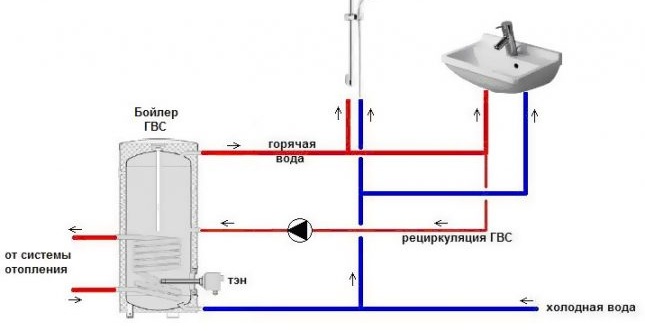
A water supply system with constant circulation of hot fluid will save several cubic meters of water per year
The way out of this situation can be found in the installation of a wiring of a closed type. A characteristic feature of this scheme is the constant circulation of hot water in a circle.Since at the same time it has a constant temperature at each point of the line, the consumer will receive hot water as soon as the valve is open. The obvious advantage of this method is complemented by another plus - the absence of sharp temperature drops, which is important for hot water systems. It has closed circulation wiring and disadvantages. A more intricate scheme complicates the installation and requires additional costs of materials and equipment. So, when installing it, you will need almost twice as many pipes, and in addition, you will have to install a separate circulation pump, which will ensure the forced movement of fluid through the system.
Algorithm for installation work
The very first step, whether it be a hidden system or an open one, is to install a control valve. Given the fact that the quality of the supplied water from their central water conduit is, to put it mildly, unsatisfactory, the installation is mandatory coarse filter. It is mounted immediately after the valve. Then a water meter is installed and fine filter (optional).
If the pressure of the supplied water in the line exceeds the permissible limits, then a pressure reducer is installed. It is important to note that the gearbox must be equipped with a manometer, through which parameters are set that will be most optimal for the operation of specific plumbing fixtures, usually 3-4 atm.
At the very end, collectors are installed. In the distribution network they are offered with outputs from 2 to 4. If there is a need, then the products can be combined. Ideally, the manifold should be equipped with shut-off valves. When connected in series, a tee is used to go to the devices.
What materials to use?
It is rather difficult to unequivocally answer this question - there are a lot of influence factors. We will only say that the most popular among the consumer audience when creating sewer pipelines and cold water systems are polypropylene and pvc pipes. Where transportation of hot water is supposed, it is worth giving preference metal plastic. The stainless heated towel rail will last longer than brass.
Errors in the design of water supply systems
Novice plumbers often make a number of mistakes that make installation of the water supply system more difficult and reduce its reliability. And although the oversights made during the operation are not critical, the risk of leaks is associated with such unpleasant factors as the appearance of mold and the destruction of the finish.
So, a few of the most common mistakes.
- The arrangement of the hot water supply system is carried out by polypropylene pipes without internal reinforcement. If a hidden installation scheme is used, then this is not a critical error. In the case when the wiring will be visible, such a mistake can lead to a decrease in the aesthetics of the structure - pipes designed for cold water will “lead” when heated.
- The system does not have enough valves or check valves are missing. Shut-off valves should be installed at the inlet of each branch and in front of all consumable points, and check valves should prevent the flow of heated water from the hot line into the cold one.
- Insulation of hot water supply during its hidden installation is not carried out. Such a “saving” leads to a drop in the temperature of the liquid along the way from the riser to the plumbing fixture. In addition, the appearance of condensation on the surface of the pipes causes the spread of mold and damage to the finishing materials.
- When drawing up the wiring diagram, it is necessary to consider the location of the pipes so that they do not overlap the joints.Subsequently, this will save a lot of time and nerves in case of leaks or the need for preventive work.
- When designing a water supply system, the placement of sewer pipes is not taken into account, which can lead to difficult access during repair.
In addition, it should be remembered that even the most ideally designed water supply system can cause a lot of trouble if its installation was carried out carelessly or in violation of technology.
With what mistakes can not be made when installing pipes in the bathroom, you had the opportunity to get acquainted a little higher. Now we offer to watch a video material where a complex collector wiring is performed correctly.
Video: collector unit device
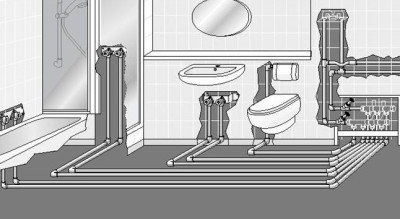
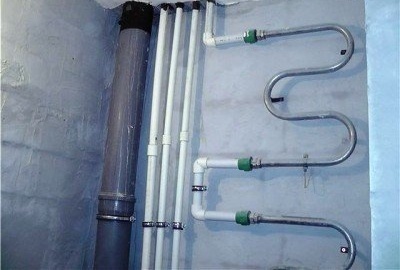
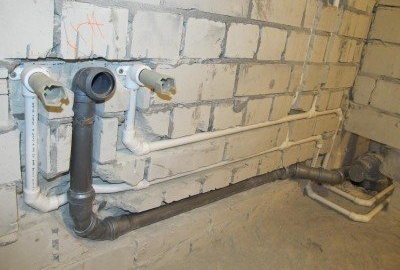
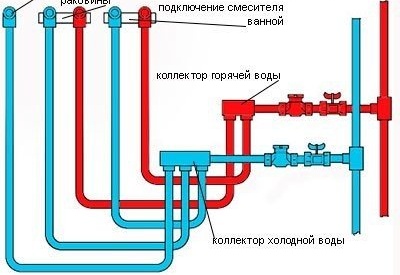
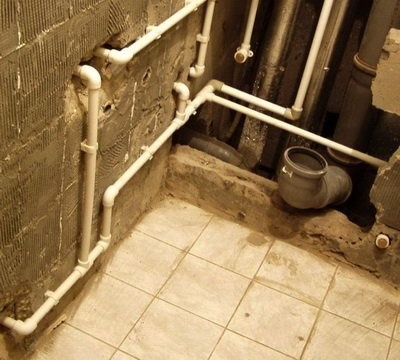
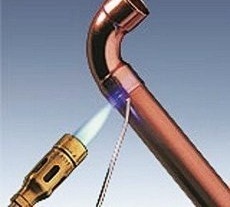
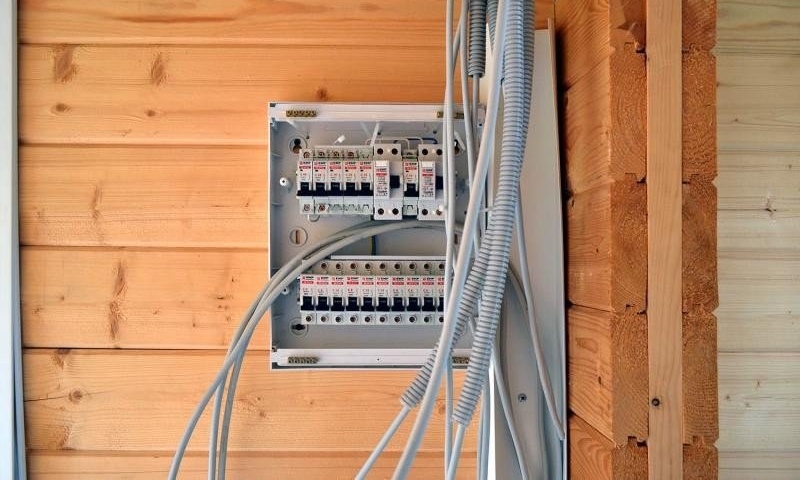
5 comments